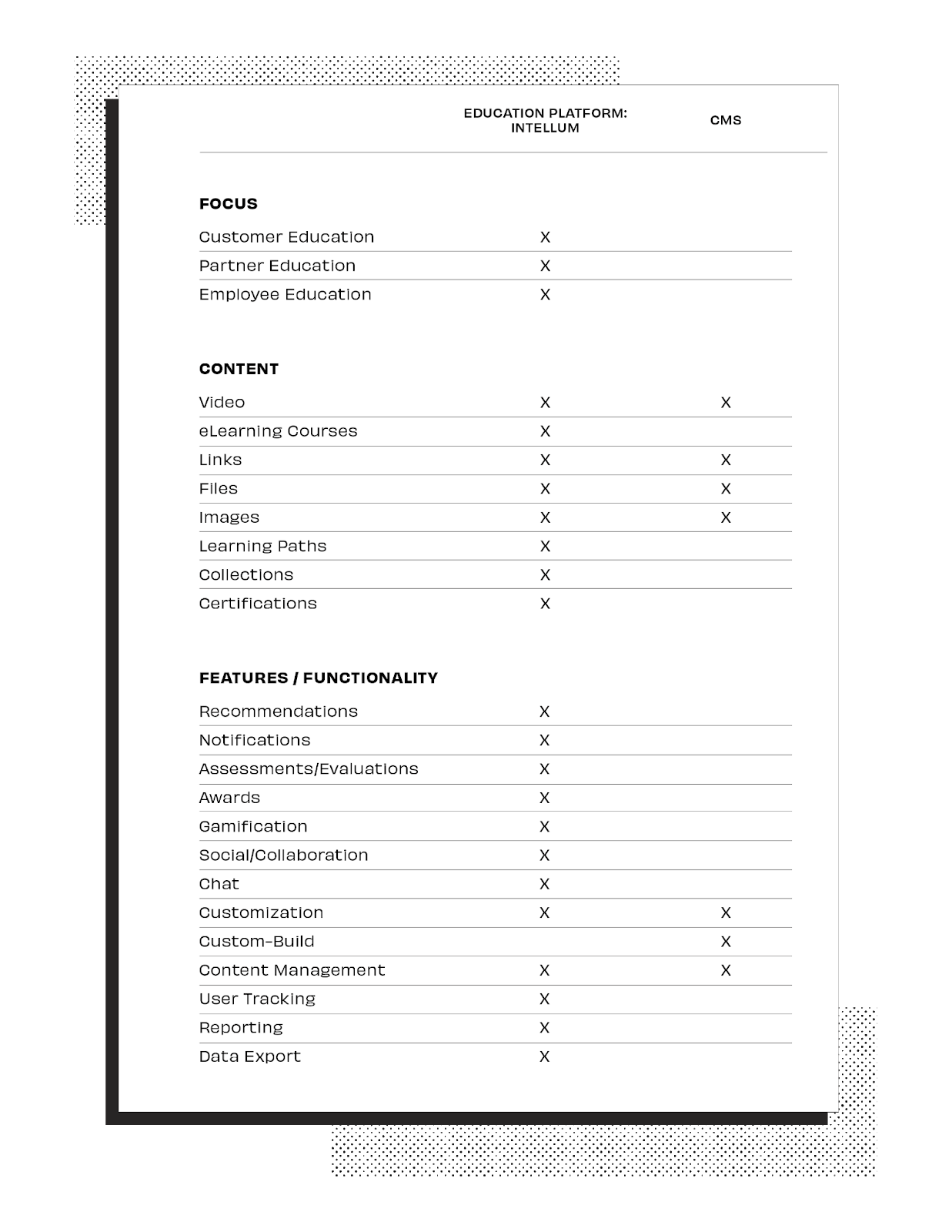We're in the End User Era, where products are built to help the end-user achieve success in their day-to-day duties. The responsibility of achieving success with a product has shifted largely to the user. While companies who follow a product-led growth mindset aim to design products that enable the end-user to achieve success, in many cases, the user still needs help to realize the full value of their investment. Enter: the need for customer education.
With new customer education initiatives springing up every day, we often talk with companies who are thinking about building education on a content management system because they know they need to deliver content, and that’s what a CMS does. But in typical “you don’t know what you don’t know” fashion, what they really need is an education platform.
After 20 years of innovating in the education space, we’ve learned a thing or two about what works to train and educate end-users - whether those users are customers, partners, or even employees.
So let’s get into the differences between a CMS and an education platform, and why an education platform is better for supporting product-led growth.

It's all about focus
The biggest difference between an education platform and a typical CMS is the degree of focus.
Education platform
An education platform is built specifically to carry out customer, partner, and employee education initiatives. Similar to a CMS, content is a central focus of the education platform, but the difference is, an education platform can serve up different content to different user audiences and tailor the experience to their needs. An education platform will provide a number of ways to create educational content and organize existing assets (like events, videos, files, and links) into learning paths for deeper contextual learning.
Our approach is based on decades of industry experience, and our solution leverages our proprietary methodology informed by the Science of Learning to help clients connect their learning initiatives to measurable business outcomes.
CMS
A CMS is not designed for any specific initiative. In fact, most CMSs are built to serve as an empty shell on top of which a more traditional website can be built. They can be filled with a wide range of content and used for a wide range of purposes, but don’t really specialize in any one thing. A CMS will offer basic levels of content organization, and the main benefit is reach and awareness aimed at large groups of anonymous users.
Active vs. passive learning
Every new learning initiative should have clear goals for the user and for the business, and these goals should determine which “state” is best for your users and your initiative.
Education Platform
An education platform is designed to keep users in an active state of learning throughout a user lifecycle. The tactics used to achieve this state of active learning are often grouped together under the terms “engagement,” and “personalization.” We have built a wide range of these tactics into Intellum’s platform (think persona-based journeys, machine-driven recommendations, notifications, awards, and real-time chat). Furthermore, quizzes, assessments, evaluations, and full-blown certifications lead to even deeper personalized experiences.
When you combine all of these things, you create an experience that compels users to consistently return to the learning environment and successfully progress through your content. In addition, these active learning environments can be built to serve up different content to users at different stages of their customer lifecycle. In turn, this type of active learning results in deeper knowledge retention and promotes positive behavioral changes in users, like growth in skills and competencies that turn them into power users.
CMS
A CMS is considered a passive user experience. Users are directed to the environment to simply read or watch content online, and every user has the same experience with that content. There are no interactive educational moments built into a CMS, like quizzes or simulations. A CMS does not make recommendations for content based on the individual user’s unique activity, history, and preferences. There are no awards or notifications inherent in a CMS, either. And that’s all ok because a CMS is not intended to be an education platform. Its purpose is to store and display content. When the goal is to simply get information in front of the user, a CMS can be the perfect fit.
Tracking and Reporting
If the goal is to make business decisions based on insights gained from the initiative, your solution needs to track and report on user activity.
Education Platform
Most education platforms will allow you to track user logins, course enrollments and completions, and user actions. The ability to track user activity and make correlations between education initiatives and business outcomes is a central focus of a great education platform. Intellum’s platform includes a powerful, native report writer that allows clients to track all user activity, engagement, and performance. Leverage off-the-shelf reports, create custom reports, export data to BI, and data visualization tools to share the impact with internal teams or other stakeholders.
Product-led pros naturally embrace this philosophy, too. With a strong focus on tracking, measuring, and analyzing end-user behavior, product-led growth companies that also rely on customer education to ensure the product achieves its ability to capture value see great results.
CMS
A CMS can be a great solution for creating, managing, deploying, and tracking revisions to passive content, but a CMS does not track or report on user behavior, engagement, or performance. In most instances, project owners are simply monitoring traffic to pages and asset views through tools like Google Analytics. They are not able to follow a unique user’s progress through their website, determine the effectiveness of an individual asset, or identify performance issues in a specific group without the help of third-party solutions - which adds complexity and cost to the project.
And the winner is...education platforms!
We hope it’s clear by now when executing educational initiatives that are tailored specifically to serve the mission of product-led growth companies - for the user to realize a product's value for themselves - the right solution is an education platform. Bite-sized learning, delivered to the right user, at the right time, results in users realizing what each of us are seeking when we buy a new product: to achieve the outcomes that were promised during the sale.
To help you further with this exercise, here’s a chart that you can use to evaluate your current, or your next, solution:

We're happy to chat and help figure out the right approach for your learning initiatives.
Visit our website to learn more.



